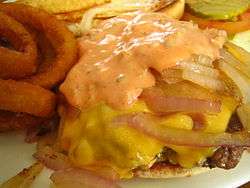Russian dressing
 Cheeseburger topped with grilled onions and Russian dressing | |
| Type | Salad dressing |
|---|---|
| Place of origin | United States |
| Region or state | New Hampshire |
| Created by | James E. Colburn |
| Main ingredients | Mayonnaise, ketchup, horseradish, pimentos, chives, spices |
Russian dressing is a piquant American salad dressing consisting of mayonnaise with ketchup and other ingredients. Russian dressing is a key ingredient in a Reuben sandwich.
History
Russian dressing is mentioned as early as 1900 in American sources.[1] It is also documented in a 1910 catering book as an alternative to vinaigrette for dressing tomatoes or asparagus.[2] A 1913 cookbook has a recipe which is a vinaigrette with paprika and mustard.[3] A mayonnaise-based recipe is documented in 1914.[4]
Local historians claim that the mayonnaise-based version was invented in Nashua, New Hampshire, by James E. Colburn in the 1910s.[5] A 1927 biographical article calls him "the originator and first producer of that delectable condiment known as Russian salad dressing".[6] Colburn had been selling "Colburn's Mayonnaise salad dressing" at his store since at least 1910.[7]
| “ | To have conferred upon the epicurean tastes of a great body of people a delicacy at once as refined as it is permanent in its popularity is not to have lived in vain; rather it is to have added to the joy of living.... [Colburn] hit upon an assembly of ingredients, which he named Russian salad dressing,... [and earned] wealth on which he was enabled to retire.... As he rests on his laurels, he is conscious of having done his part well in conferring a blessing upon the people who have learned the art of eating well. | ” |
| — Hobart Pillsbury, New Hampshire Resources...[6] | ||
Certainly by 1914, Colburn's company was manufacturing it,[8] and distributing it to retailers and hotels. He earned enough from its sale that he retired in 1924.[6]
It is unknown in traditional Russian cuisine, but Russians call it "ketchunnaise" (кетчунез).
Preparation
Typically piquant, it is today characteristically made of a blend of mayonnaise and ketchup complemented with such additional ingredients as horseradish, pimentos, chives, pickled cucumber (relish) and spices.[9][10]
Use
Besides being used as a salad dressing, Russian dressing is also used as a sandwich spread for Reuben sandwiches.
Related sauces
Russian dressing has largely been supplanted by Thousand Island dressing, which is sweeter and less spicy than Russian.[6]
Other combinations of mayonnaise and ketchup, but without the spicy ingredients, are known as fry sauce or other names, and typically served with french fries or tostones.
Tartar sauce has the piquant ingredients of Russian dressing, but not ketchup. It is typically served with fried fish.
Marie Rose sauce is similar to Russian dressing, but with different piquant ingredients. It is typically served with seafood.
A variant known as red Russian dressing is very much like Catalina or French dressing.[11]
In Germany, a similar salad dressing is called "American Dressing".[12][13]
References
- ↑ Frederick, Maryland News March 24, 1900 5/3, quoted in the Oxford English Dictionary, Third Edition, March 2011 s.v.
- ↑ Charles Fellows, The Menu Maker, The Hotel Monthly Press, 1910, [https://books.google.com/books?id=XbQv2SNlbNEC&pg=RA1-PA114#v=onepage&q=russian%20dressing%23v%3Dsnippet&f=false p. 114
- ↑ Margaret McHale, The C.W.C. Cook Book, Catholic Women's Club, 1913, "russian+dressing" p. 76
- ↑ Clearfield, Pennsylvania Progress, 7 May 1914, p. 10, as quoted in Barry Popik's blog entry of 28 November 2006
- ↑ Shalhoup, Dean (22 July 2012). "City gave roots to numerous famous inventions". Nashua Telegraph. Retrieved 22 July 2012.
- 1 2 3 4 John Holl, "America was sweet on its spicy Russian dressing — until Thousand Island, that is", Washington Post 22 December 2014
- ↑ "Local Mention", Nashua Telegraph, 6 May 1910, p. 10
- ↑ "Colburn popularized Mayonnaise". Nashua Telegraph. 30 July 1930. Retrieved 13 April 2018. "for over sixteen years"
- ↑ Stewart, Frances Elizabeth (1920). Lessons in Cookery. 2. New York, New York (USA): Rand McNally & Company. p. 123. Retrieved 13 April 2012.
- ↑ George, Mrs. Alexander (24 April 1941). "Menus of the Day". Lewiston Morning Tribune. Lewiston, Idaho, USA. p. 3. Retrieved 13 April 2012.
- ↑ Welzel, Karin. "Catalina dressing substitutes for Russian in recipe". Pittsburgh Tribune-Review. Retrieved 21 November 2016.
- ↑ Kochbuch, Marions. "American Dressing". Marions Kochbuch. Folkert Knieper. Retrieved 7 August 2018.
- ↑ Meena, Ava (29 January 2016). "American Food According to Germany". My Meena Life. Retrieved 7 August 2018.
.jpg)